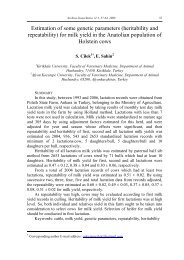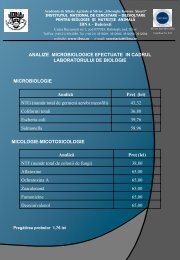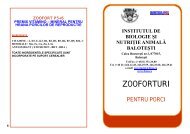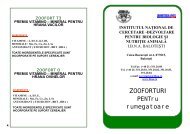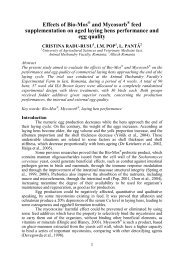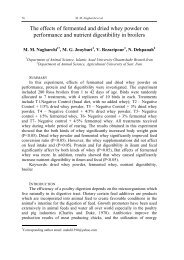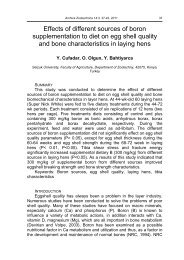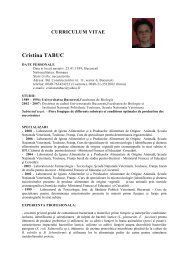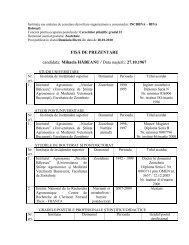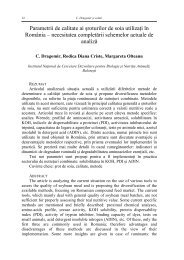Effect of Cr picolinate and Zn supplementation on plasma ... - IBNA
Effect of Cr picolinate and Zn supplementation on plasma ... - IBNA
Effect of Cr picolinate and Zn supplementation on plasma ... - IBNA
You also want an ePaper? Increase the reach of your titles
YUMPU automatically turns print PDFs into web optimized ePapers that Google loves.
78<br />
Yanchev et al.<br />
<str<strong>on</strong>g>Effect</str<strong>on</strong>g> <str<strong>on</strong>g>of</str<strong>on</strong>g> <str<strong>on</strong>g>Cr</str<strong>on</strong>g> <str<strong>on</strong>g>picolinate</str<strong>on</strong>g> <str<strong>on</strong>g>and</str<strong>on</strong>g> <str<strong>on</strong>g>Zn</str<strong>on</strong>g> <str<strong>on</strong>g>supplementati<strong>on</strong></str<strong>on</strong>g> <strong>on</strong> <strong>plasma</strong><br />
cortisol <str<strong>on</strong>g>and</str<strong>on</strong>g> some metabolite levels in Charolais hoggets<br />
during acclimatizati<strong>on</strong><br />
I. Yanchev, D. Gudev, S. Ralcheva, P. M<strong>on</strong>eva<br />
Institute <str<strong>on</strong>g>of</str<strong>on</strong>g> Animal Science – Kostinbrod, Bulgaria<br />
ABSTRACT<br />
The effect <str<strong>on</strong>g>of</str<strong>on</strong>g> <str<strong>on</strong>g>Cr</str<strong>on</strong>g> <str<strong>on</strong>g>and</str<strong>on</strong>g> <str<strong>on</strong>g>Cr</str<strong>on</strong>g>+<str<strong>on</strong>g>Zn</str<strong>on</strong>g> treatment <strong>on</strong> adrenal resp<strong>on</strong>se to stress in<br />
newly imported Charolais hoggets after the quarantine period was investigated.<br />
Chromium <str<strong>on</strong>g>and</str<strong>on</strong>g> <str<strong>on</strong>g>Cr</str<strong>on</strong>g>+<str<strong>on</strong>g>Zn</str<strong>on</strong>g> implicati<strong>on</strong> in carbohydrate <str<strong>on</strong>g>and</str<strong>on</strong>g> protein metabolism as<br />
evidenced by the levels <str<strong>on</strong>g>of</str<strong>on</strong>g> some metabolites was studied, too.<br />
Eighteen <strong>on</strong>e year old Charolais hoggets were divided into three groups:<br />
c<strong>on</strong>trol group, <str<strong>on</strong>g>Cr</str<strong>on</strong>g> <str<strong>on</strong>g>and</str<strong>on</strong>g> <str<strong>on</strong>g>Cr</str<strong>on</strong>g>+<str<strong>on</strong>g>Zn</str<strong>on</strong>g> experimental groups- given supplemental dietary<br />
<str<strong>on</strong>g>Cr</str<strong>on</strong>g> <str<strong>on</strong>g>picolinate</str<strong>on</strong>g> <str<strong>on</strong>g>and</str<strong>on</strong>g> <str<strong>on</strong>g>Zn</str<strong>on</strong>g>SO 4·7H 2 O respectively. Plasma cortisol, glucose,<br />
cholesterol, urea <str<strong>on</strong>g>and</str<strong>on</strong>g> indole levels were measured.<br />
Supplemental <str<strong>on</strong>g>Cr</str<strong>on</strong>g>+<str<strong>on</strong>g>Zn</str<strong>on</strong>g> caused cortisol decline by 2 nd <str<strong>on</strong>g>and</str<strong>on</strong>g> increase by 9 th day,<br />
but didn’t have any influence <strong>on</strong> 5 th day. Chromium al<strong>on</strong>e had no significant<br />
effect <strong>on</strong> <strong>plasma</strong> cortisol level by 2 nd day but increased cortisol level by 9 th day.<br />
Plasma glucose level was not influenced by supplemental <str<strong>on</strong>g>Cr</str<strong>on</strong>g> or <str<strong>on</strong>g>Cr</str<strong>on</strong>g>+<str<strong>on</strong>g>Zn</str<strong>on</strong>g>.<br />
Supplemental <str<strong>on</strong>g>Cr</str<strong>on</strong>g>+<str<strong>on</strong>g>Zn</str<strong>on</strong>g> caused significant decline in <strong>plasma</strong> cholesterol, urea <str<strong>on</strong>g>and</str<strong>on</strong>g><br />
indole levels by 2 nd day. It is suggested that the enumerated effects <str<strong>on</strong>g>of</str<strong>on</strong>g><br />
supplemental <str<strong>on</strong>g>Cr</str<strong>on</strong>g>+<str<strong>on</strong>g>Zn</str<strong>on</strong>g> are mediated via the hypothalamic-pituitary adrenal axis.<br />
Key words: Chromium, zinc, Charolais hoggets, cortisol, glucose,<br />
cholesterol, urea, indole<br />
INTRODUCTION<br />
Trivalent <str<strong>on</strong>g>Cr</str<strong>on</strong>g> is an essential trace mineral that is involved in carbohydrate,<br />
lipid, <str<strong>on</strong>g>and</str<strong>on</strong>g> protein metabolism. Mertz et al. (1974) showed that <str<strong>on</strong>g>Cr</str<strong>on</strong>g> potentiates the<br />
effects <str<strong>on</strong>g>of</str<strong>on</strong>g> insulin <str<strong>on</strong>g>and</str<strong>on</strong>g>, therefore, improves carbohydrate metabolism, <str<strong>on</strong>g>and</str<strong>on</strong>g> they<br />
c<strong>on</strong>cluded that protein synthesis may be affected positively as well.<br />
In additi<strong>on</strong>, Chang <str<strong>on</strong>g>and</str<strong>on</strong>g> Mowat (1992) found that supplemental <str<strong>on</strong>g>Cr</str<strong>on</strong>g> seemed<br />
to improve the immune status <str<strong>on</strong>g>of</str<strong>on</strong>g> stressed ruminants; however, these effects are<br />
not c<strong>on</strong>sistent (Chang et al., 1994; Mathis<strong>on</strong> <str<strong>on</strong>g>and</str<strong>on</strong>g> Engstrom, 1995). Chromium<br />
tri<str<strong>on</strong>g>picolinate</str<strong>on</strong>g> was used as the <str<strong>on</strong>g>Cr</str<strong>on</strong>g> source because previous research has suggested<br />
that <str<strong>on</strong>g>Cr</str<strong>on</strong>g> is more available as an organic chelate (Evans, 1982; Chang et al., 1992;<br />
Page et al., 1993).<br />
The ability <str<strong>on</strong>g>of</str<strong>on</strong>g> zinc to retard oxidative processes has been recognized for<br />
many years. In general, the mechanism <str<strong>on</strong>g>of</str<strong>on</strong>g> antioxidati<strong>on</strong> can be divided into
Archiva Zootechnica vol. 10, 2007 79<br />
acute <str<strong>on</strong>g>and</str<strong>on</strong>g> chr<strong>on</strong>ic effects. Chr<strong>on</strong>ic effects involve exposure <str<strong>on</strong>g>of</str<strong>on</strong>g> an organism to<br />
zinc <strong>on</strong> a l<strong>on</strong>g-term basis, resulting in inducti<strong>on</strong> <str<strong>on</strong>g>of</str<strong>on</strong>g> some other substance that is<br />
the ultimate antioxidant, such as the metallothi<strong>on</strong>eins. Chr<strong>on</strong>ic zinc deprivati<strong>on</strong><br />
generally results in increased sensitivity to some oxidative stress. The acute<br />
effects involve two mechanisms: protecti<strong>on</strong> <str<strong>on</strong>g>of</str<strong>on</strong>g> protein sulfhydryls or reducti<strong>on</strong><br />
<str<strong>on</strong>g>of</str<strong>on</strong>g> -OH formati<strong>on</strong> from H 2 O 2 through the antag<strong>on</strong>ism <str<strong>on</strong>g>of</str<strong>on</strong>g> redox-active transiti<strong>on</strong><br />
metals, such as ir<strong>on</strong> <str<strong>on</strong>g>and</str<strong>on</strong>g> copper (Afanas et al., 1995; Aiuto et al., 1995).<br />
Most <str<strong>on</strong>g>of</str<strong>on</strong>g> the <str<strong>on</strong>g>Cr</str<strong>on</strong>g> nutriti<strong>on</strong> studies have focused <strong>on</strong> the role <str<strong>on</strong>g>of</str<strong>on</strong>g> <str<strong>on</strong>g>Cr</str<strong>on</strong>g> in<br />
preventing insulin resistance, however, interacti<strong>on</strong>s am<strong>on</strong>g insulin sensitizers<br />
<str<strong>on</strong>g>and</str<strong>on</strong>g> antioxidants should also be evaluated as suggested by Preuss (1998) <str<strong>on</strong>g>and</str<strong>on</strong>g><br />
Anders<strong>on</strong> et al. (2001).<br />
Hence, the objectives <str<strong>on</strong>g>of</str<strong>on</strong>g> this article are:<br />
• To study the effect <str<strong>on</strong>g>of</str<strong>on</strong>g> <str<strong>on</strong>g>Cr</str<strong>on</strong>g> <str<strong>on</strong>g>and</str<strong>on</strong>g> <str<strong>on</strong>g>Cr</str<strong>on</strong>g>+<str<strong>on</strong>g>Zn</str<strong>on</strong>g> treatment <strong>on</strong> adrenal resp<strong>on</strong>se<br />
to stress <str<strong>on</strong>g>of</str<strong>on</strong>g> newly imported Charolais hoggets after the quarantine period;<br />
• To investigate <str<strong>on</strong>g>Cr</str<strong>on</strong>g> <str<strong>on</strong>g>and</str<strong>on</strong>g> <str<strong>on</strong>g>Cr</str<strong>on</strong>g>+<str<strong>on</strong>g>Zn</str<strong>on</strong>g> implicati<strong>on</strong> in carbohydrate <str<strong>on</strong>g>and</str<strong>on</strong>g><br />
protein metabolism as evidenced by the levels <str<strong>on</strong>g>of</str<strong>on</strong>g> some metabolites.<br />
MATERIAL AND METHODS<br />
Eighteen <strong>on</strong>e year old Charolais hoggets were transported from the<br />
mountainous base ”Zlatusha” after the quarantine period following importati<strong>on</strong><br />
from France to the experimental barn <str<strong>on</strong>g>of</str<strong>on</strong>g> the Institute <str<strong>on</strong>g>of</str<strong>on</strong>g> Animal Science –<br />
Kostinbrod. They were divided into three groups as follows: c<strong>on</strong>trol group – fed<br />
according to the nutriti<strong>on</strong>al st<str<strong>on</strong>g>and</str<strong>on</strong>g>ards <str<strong>on</strong>g>and</str<strong>on</strong>g> two experimental groups. Hoggets in<br />
the first experimental group were given organic chromium as <str<strong>on</strong>g>Cr</str<strong>on</strong>g> <str<strong>on</strong>g>picolinate</str<strong>on</strong>g><br />
(“Kromisan” ® , produced by “Jastfri-Lactosfri Sockerfri”-Finl<str<strong>on</strong>g>and</str<strong>on</strong>g>) <str<strong>on</strong>g>and</str<strong>on</strong>g> that in<br />
sec<strong>on</strong>d experimental group - <str<strong>on</strong>g>Cr</str<strong>on</strong>g> <str<strong>on</strong>g>picolinate</str<strong>on</strong>g> plus <str<strong>on</strong>g>Zn</str<strong>on</strong>g> given as <str<strong>on</strong>g>Zn</str<strong>on</strong>g>SO 4 .7 H 2 O. Basal<br />
diet was formulated according to nutriti<strong>on</strong>al requirements for the corresp<strong>on</strong>ding<br />
age (NRC). Chromium <str<strong>on</strong>g>and</str<strong>on</strong>g> Zinc c<strong>on</strong>tent in basal diet was not determined since<br />
the effect <str<strong>on</strong>g>of</str<strong>on</strong>g> <str<strong>on</strong>g>Cr</str<strong>on</strong>g> depends <strong>on</strong> the intensity <str<strong>on</strong>g>and</str<strong>on</strong>g> durati<strong>on</strong> <str<strong>on</strong>g>of</str<strong>on</strong>g> the applied stress<br />
stimuli.<br />
Hoggets in the experimental groups were treated for 9 c<strong>on</strong>secutive days<br />
with <str<strong>on</strong>g>Cr</str<strong>on</strong>g> <str<strong>on</strong>g>and</str<strong>on</strong>g> <str<strong>on</strong>g>Cr</str<strong>on</strong>g>+<str<strong>on</strong>g>Zn</str<strong>on</strong>g> soluti<strong>on</strong>s given per os <str<strong>on</strong>g>and</str<strong>on</strong>g> blood samples were taken by<br />
jugular venipuncture after 2 nd , 5 th <str<strong>on</strong>g>and</str<strong>on</strong>g> 9 th treatment. Chromium c<strong>on</strong>centrati<strong>on</strong> in<br />
both experimental groups was 100 <br />
<br />
was 30 mg per animal, daily.<br />
Cortisol level was determined by radioimmunoassay (Kanchev et al.,<br />
1976). All assays were performed in duplicate. Inter- <str<strong>on</strong>g>and</str<strong>on</strong>g> intra-assay<br />
coefficients <str<strong>on</strong>g>of</str<strong>on</strong>g> variati<strong>on</strong> were 9.9% <str<strong>on</strong>g>and</str<strong>on</strong>g> 6.7% respectively. Plasma glucose level<br />
was determined by the method <str<strong>on</strong>g>of</str<strong>on</strong>g> Ceriotti as modified by Pr<str<strong>on</strong>g>of</str<strong>on</strong>g>irov (1990) <str<strong>on</strong>g>and</str<strong>on</strong>g><br />
<strong>plasma</strong> total cholesterol <str<strong>on</strong>g>and</str<strong>on</strong>g> indole levels were measured by the method <str<strong>on</strong>g>of</str<strong>on</strong>g><br />
Wats<strong>on</strong> (1960) <str<strong>on</strong>g>and</str<strong>on</strong>g> Balakovsky (Chilov, 1959), respectively. Plasma urea levels<br />
were assayed as described by Rerat et al., 1979.
80<br />
Yanchev et al.<br />
The results <str<strong>on</strong>g>of</str<strong>on</strong>g> <strong>on</strong>e factor statistical analysis are expressed as means ±<br />
S.E.M. <str<strong>on</strong>g>and</str<strong>on</strong>g> were analyzed by Student t-test. When the results were statistically<br />
processed by the use <str<strong>on</strong>g>of</str<strong>on</strong>g> two factors analysis the difference was less than 3%.<br />
Fig. 1: Plasma cortisol level<br />
5<br />
ng/ml<br />
4<br />
3<br />
2<br />
1<br />
C<strong>on</strong>trol<br />
<str<strong>on</strong>g>Cr</str<strong>on</strong>g><br />
<str<strong>on</strong>g>Cr</str<strong>on</strong>g>+<str<strong>on</strong>g>Zn</str<strong>on</strong>g><br />
0<br />
2 day 5 day 9 day<br />
Experimental period<br />
RESULTS AND DISCUSSION<br />
Chromium <str<strong>on</strong>g>supplementati<strong>on</strong></str<strong>on</strong>g> had no significant effect <strong>on</strong> <strong>plasma</strong> cortisol<br />
levels by the 2 nd <str<strong>on</strong>g>and</str<strong>on</strong>g> 5 th day after the transport <str<strong>on</strong>g>and</str<strong>on</strong>g> accommodati<strong>on</strong> <str<strong>on</strong>g>of</str<strong>on</strong>g> hoggets<br />
to the new envir<strong>on</strong>ment (Fig. 1). Presently <str<strong>on</strong>g>Cr</str<strong>on</strong>g> sufficiency is assessed by the<br />
ability <str<strong>on</strong>g>of</str<strong>on</strong>g> supplemental <str<strong>on</strong>g>Cr</str<strong>on</strong>g> to reduce stress-induced changes. The very fact that<br />
supplemental <str<strong>on</strong>g>Cr</str<strong>on</strong>g> did not influence <strong>plasma</strong> cortisol level suggests that the<br />
intensity <str<strong>on</strong>g>and</str<strong>on</strong>g> durati<strong>on</strong> <str<strong>on</strong>g>of</str<strong>on</strong>g> stress-eliciting factors under the c<strong>on</strong>diti<strong>on</strong>s <str<strong>on</strong>g>of</str<strong>on</strong>g> our<br />
experiment were not enough to reduce body stores <str<strong>on</strong>g>of</str<strong>on</strong>g> <str<strong>on</strong>g>Cr</str<strong>on</strong>g>. Another noteworthy<br />
point is that the increase <str<strong>on</strong>g>of</str<strong>on</strong>g> <strong>plasma</strong> cortisol level <strong>on</strong> the 9 th day (p
Archiva Zootechnica vol. 10, 2007 81<br />
period except <strong>on</strong> the 2 nd day in the <str<strong>on</strong>g>Cr</str<strong>on</strong>g> treated group (Fig. 3). These data are in<br />
accordance with our previous study (Yanchev et al., 2003) <str<strong>on</strong>g>and</str<strong>on</strong>g> with most <str<strong>on</strong>g>of</str<strong>on</strong>g> the<br />
investigati<strong>on</strong>s in this field. Despite the numerous hypotheses c<strong>on</strong>cerning the<br />
cholesterol reducing effect <str<strong>on</strong>g>of</str<strong>on</strong>g> <str<strong>on</strong>g>Cr</str<strong>on</strong>g> <str<strong>on</strong>g>and</str<strong>on</strong>g> <str<strong>on</strong>g>Zn</str<strong>on</strong>g>, the mechanism <str<strong>on</strong>g>of</str<strong>on</strong>g> their effect is not<br />
fully explained.<br />
Fig. 2: Plasma glucose level<br />
mg %<br />
120<br />
100<br />
80<br />
60<br />
40<br />
20<br />
0<br />
2 day 5 day 9 day<br />
Experimental period<br />
C<strong>on</strong>trol<br />
<str<strong>on</strong>g>Cr</str<strong>on</strong>g><br />
<str<strong>on</strong>g>Cr</str<strong>on</strong>g>+<str<strong>on</strong>g>Zn</str<strong>on</strong>g><br />
Fig 3: Plasma cholesterol level<br />
mg %<br />
90<br />
80<br />
70<br />
60<br />
50<br />
40<br />
30<br />
20<br />
10<br />
0<br />
2 day 5 day 9 day<br />
Experimental period<br />
C<strong>on</strong>trol<br />
<str<strong>on</strong>g>Cr</str<strong>on</strong>g><br />
<str<strong>on</strong>g>Cr</str<strong>on</strong>g>+<str<strong>on</strong>g>Zn</str<strong>on</strong>g><br />
Both <str<strong>on</strong>g>Cr</str<strong>on</strong>g> <str<strong>on</strong>g>and</str<strong>on</strong>g> <str<strong>on</strong>g>Cr</str<strong>on</strong>g>+<str<strong>on</strong>g>Zn</str<strong>on</strong>g> <str<strong>on</strong>g>supplementati<strong>on</strong></str<strong>on</strong>g> had no significant effect <strong>on</strong> <strong>plasma</strong><br />
urea level by 5 th <str<strong>on</strong>g>and</str<strong>on</strong>g> 9 th day. However the combinati<strong>on</strong> <str<strong>on</strong>g>Cr</str<strong>on</strong>g>+<str<strong>on</strong>g>Zn</str<strong>on</strong>g> caused<br />
synergistic urea-decreasing effect by 2 nd day (Fig. 4). This finding is in<br />
accordance with the above menti<strong>on</strong>ed view that supplemental <str<strong>on</strong>g>Cr</str<strong>on</strong>g>+<str<strong>on</strong>g>Zn</str<strong>on</strong>g> has better<br />
stress-alleviating effect than <str<strong>on</strong>g>Cr</str<strong>on</strong>g> supplement, given al<strong>on</strong>e. These results are in<br />
c<strong>on</strong>trast with those, found in our previous study cited above, where we found<br />
higher <strong>plasma</strong> urea levels in weaned lambs given inorganic <str<strong>on</strong>g>Cr</str<strong>on</strong>g>. The inc<strong>on</strong>sistent<br />
results reported in many studies could result from factors such as experimental<br />
design, age <str<strong>on</strong>g>of</str<strong>on</strong>g> the experimental animals, chemical form <str<strong>on</strong>g>of</str<strong>on</strong>g> the supplemental <str<strong>on</strong>g>Cr</str<strong>on</strong>g>,<br />
diet structure, etc.
82<br />
Yanchev et al.<br />
Fig. 4: Plasma urea level<br />
mg %<br />
80<br />
70<br />
60<br />
50<br />
40<br />
30<br />
20<br />
10<br />
0<br />
2 day 5 day 9 day<br />
Experimental period<br />
C<strong>on</strong>trol<br />
<str<strong>on</strong>g>Cr</str<strong>on</strong>g><br />
<str<strong>on</strong>g>Cr</str<strong>on</strong>g>+<str<strong>on</strong>g>Zn</str<strong>on</strong>g><br />
Fig 5: Plasma indol level<br />
µg/ml<br />
45<br />
40<br />
35<br />
30<br />
25<br />
20<br />
15<br />
10<br />
5<br />
0<br />
2 day 5 day 9 day<br />
Experimental period<br />
C<strong>on</strong>trol<br />
<str<strong>on</strong>g>Cr</str<strong>on</strong>g><br />
<str<strong>on</strong>g>Cr</str<strong>on</strong>g>+<str<strong>on</strong>g>Zn</str<strong>on</strong>g><br />
It is barely coincidental that <str<strong>on</strong>g>Cr</str<strong>on</strong>g>+<str<strong>on</strong>g>Zn</str<strong>on</strong>g> induced decrease in <strong>plasma</strong> cortisol<br />
level <strong>on</strong> 2 nd day was accompanied by a decline in cholesterol <str<strong>on</strong>g>and</str<strong>on</strong>g> urea levels.<br />
Puvadolpirod <str<strong>on</strong>g>and</str<strong>on</strong>g> Thaxst<strong>on</strong> (2000) have reported that exogenous<br />
adrenocorticotrophin increased <strong>plasma</strong> cholesterol level. Therefore the observed<br />
decline <str<strong>on</strong>g>of</str<strong>on</strong>g> <strong>plasma</strong> cholesterol level <strong>on</strong> 2d in 3 rd group <str<strong>on</strong>g>of</str<strong>on</strong>g> hoggets was probably<br />
due to <str<strong>on</strong>g>Cr</str<strong>on</strong>g>+<str<strong>on</strong>g>Zn</str<strong>on</strong>g> induced decline in <strong>plasma</strong> cortisol <str<strong>on</strong>g>and</str<strong>on</strong>g> adrenocorticotrophin<br />
respectively. However this explanati<strong>on</strong> is not c<strong>on</strong>sistent with the observed lower<br />
<strong>plasma</strong> cholesterol levels <strong>on</strong> 5d <str<strong>on</strong>g>and</str<strong>on</strong>g> 9d in groups II <str<strong>on</strong>g>and</str<strong>on</strong>g> III despite the<br />
unchanged or increased cortisol levels <strong>on</strong> 5 <str<strong>on</strong>g>and</str<strong>on</strong>g> 9d respectively. Urea level can<br />
be influenced by the activity <str<strong>on</strong>g>of</str<strong>on</strong>g> hypothalamic-pituitary adrenal axis as well.<br />
Adrenal secreti<strong>on</strong> <str<strong>on</strong>g>of</str<strong>on</strong>g> cortisol is c<strong>on</strong>trolled by hypothalamic release <str<strong>on</strong>g>of</str<strong>on</strong>g><br />
corticotrophin releasing horm<strong>on</strong>e which is known to affect the rate <str<strong>on</strong>g>of</str<strong>on</strong>g> digesta<br />
passage. Besides it decreases feed intake (Lenz, 1987). C<strong>on</strong>sequently, the<br />
decline <str<strong>on</strong>g>of</str<strong>on</strong>g> cortisol as a result <str<strong>on</strong>g>of</str<strong>on</strong>g> decreased corticotrophin releasing horm<strong>on</strong>e, by<br />
2 nd day in <str<strong>on</strong>g>Cr</str<strong>on</strong>g>+<str<strong>on</strong>g>Zn</str<strong>on</strong>g> supplemented hoggets could provoke changes in the rate <str<strong>on</strong>g>of</str<strong>on</strong>g><br />
feed intake <str<strong>on</strong>g>and</str<strong>on</strong>g> the rate <str<strong>on</strong>g>of</str<strong>on</strong>g> feed transiti<strong>on</strong>. These corticotrophin releasing
Archiva Zootechnica vol. 10, 2007 83<br />
horm<strong>on</strong>e induced changes are directly related with the rate <str<strong>on</strong>g>of</str<strong>on</strong>g> amm<strong>on</strong>ia release<br />
<str<strong>on</strong>g>and</str<strong>on</strong>g> its utilizati<strong>on</strong> by rumen micr<str<strong>on</strong>g>of</str<strong>on</strong>g>lora for synthesis <str<strong>on</strong>g>of</str<strong>on</strong>g> its own proteins.<br />
Our results suggest that supplemental <str<strong>on</strong>g>Cr</str<strong>on</strong>g>+<str<strong>on</strong>g>Zn</str<strong>on</strong>g> may have caused reduced diet<br />
c<strong>on</strong>sumpti<strong>on</strong>, less feed protein intake as established Gentry et al. (1999), lower<br />
level <str<strong>on</strong>g>of</str<strong>on</strong>g> released NH 3 <str<strong>on</strong>g>and</str<strong>on</strong>g> better NH 3 utilizati<strong>on</strong> by rumen microorganisms, thus<br />
reducing the level <str<strong>on</strong>g>of</str<strong>on</strong>g> amm<strong>on</strong>ium that has to be detoxicated as urea in the liver.<br />
Plasma indole level in 3 rd group <str<strong>on</strong>g>of</str<strong>on</strong>g> hoggets given supplemental <str<strong>on</strong>g>Cr</str<strong>on</strong>g>+<str<strong>on</strong>g>Zn</str<strong>on</strong>g> were<br />
significantly lower (p
84<br />
Yanchev et al.<br />
Chang, X., <str<strong>on</strong>g>and</str<strong>on</strong>g> D. N. Mowat, Supplemental chromium for stressed <str<strong>on</strong>g>and</str<strong>on</strong>g> growing<br />
feeder calves. J. Anim. Sci. 70: 559-565, 1992<br />
Chang, X., D. N. Mowat, <str<strong>on</strong>g>and</str<strong>on</strong>g> B. A. Mallard. Supplemental chromium <str<strong>on</strong>g>and</str<strong>on</strong>g><br />
niacin for stressed feeder calves. Can. J. Anim. Sci. 75:351-358, 1994<br />
Chang, X., D. N. Mowat, <str<strong>on</strong>g>and</str<strong>on</strong>g> G. A. Spiers. Carcass characteristics <str<strong>on</strong>g>and</str<strong>on</strong>g> tissue<br />
mineral c<strong>on</strong>tents <str<strong>on</strong>g>of</str<strong>on</strong>g> steers fed supplemental chromium. Can. J. Anim. Sci.<br />
72:663-669, 1992<br />
Chilov, K. Clinical laboratory investigati<strong>on</strong>s <str<strong>on</strong>g>and</str<strong>on</strong>g> their practical importance.<br />
Medical <str<strong>on</strong>g>and</str<strong>on</strong>g> physical culture, S<str<strong>on</strong>g>of</str<strong>on</strong>g>ia, 235, 1959<br />
Evans, G. W. The role <str<strong>on</strong>g>of</str<strong>on</strong>g> picolinic acid in metal metabolism. Life Chem. Rep.<br />
1:57, 1982<br />
Gentry, L. R., J. M. Fern<str<strong>on</strong>g>and</str<strong>on</strong>g>ez, T. L. Ward, T. W. White, L. L. Southern, T. D.<br />
Bidner, D. L. Thomps<strong>on</strong>, Jr., D. W. Horohov, A. M. Chapa, <str<strong>on</strong>g>and</str<strong>on</strong>g> T. Sahlu.<br />
Dietary Protein <str<strong>on</strong>g>and</str<strong>on</strong>g> Chromium Tri<str<strong>on</strong>g>picolinate</str<strong>on</strong>g> in Suffolk Wether Hoggets:<br />
<str<strong>on</strong>g>Effect</str<strong>on</strong>g>s <strong>on</strong> Producti<strong>on</strong> Characteristics, Metabolic <str<strong>on</strong>g>and</str<strong>on</strong>g> Horm<strong>on</strong>al Resp<strong>on</strong>ses,<br />
<str<strong>on</strong>g>and</str<strong>on</strong>g> Immune Status, J. Anim. Sci. 77:1284–1294, 1999<br />
Kanchev, L. N., H. Dobs<strong>on</strong>, W. K. Ward, <str<strong>on</strong>g>and</str<strong>on</strong>g> R. J. Fitzpatric. C<strong>on</strong>centrati<strong>on</strong> <str<strong>on</strong>g>of</str<strong>on</strong>g><br />
steroids in bovine peripheral <strong>plasma</strong> during oestrus cycle <str<strong>on</strong>g>and</str<strong>on</strong>g> the effect <str<strong>on</strong>g>of</str<strong>on</strong>g><br />
betamethas<strong>on</strong>e treatment. J. Repr. Fert. 48: 341-345, 1976<br />
Lenz, H. T. Extrapituitary effects <str<strong>on</strong>g>of</str<strong>on</strong>g> corticotropin releasing factor. Metabol.<br />
Res. Supp. 16. 17-23, 1987<br />
Mathis<strong>on</strong>, G. W., <str<strong>on</strong>g>and</str<strong>on</strong>g> D. F. Engstrom. Chromium <str<strong>on</strong>g>and</str<strong>on</strong>g> protein supplements for<br />
growing-finishing beef steers fed barley-based diets. Can. J. Anim. Sci.<br />
75:549-558, 1995<br />
Mertz, W., E. W. Topfer, E. E. Roginski, <str<strong>on</strong>g>and</str<strong>on</strong>g> M. M. Polansky. Present<br />
knowledge <str<strong>on</strong>g>of</str<strong>on</strong>g> the role <str<strong>on</strong>g>of</str<strong>on</strong>g> <str<strong>on</strong>g>Cr</str<strong>on</strong>g>. Fed. Proc. 33:2275-2280, 1974<br />
Page, T. G., L. L. Southern, T. L. Ward, <str<strong>on</strong>g>and</str<strong>on</strong>g> D. L. Thomps<strong>on</strong>, Jr. <str<strong>on</strong>g>Effect</str<strong>on</strong>g> <str<strong>on</strong>g>of</str<strong>on</strong>g><br />
chromium <str<strong>on</strong>g>picolinate</str<strong>on</strong>g> <strong>on</strong> growth <str<strong>on</strong>g>and</str<strong>on</strong>g> serum <str<strong>on</strong>g>and</str<strong>on</strong>g> carcass traits <str<strong>on</strong>g>of</str<strong>on</strong>g> growingfinishing<br />
pigs. J. Anim. Sci. 71: 656-662, 1993<br />
Preuss, H. G. The insulin system: influence <str<strong>on</strong>g>of</str<strong>on</strong>g> antioxidants. J. Amer. Coll. Nutr.<br />
17: 101–102, 1998<br />
Pr<str<strong>on</strong>g>of</str<strong>on</strong>g>irov, Y. Amilolytic activity in the digestive tract <str<strong>on</strong>g>of</str<strong>on</strong>g> lambs during the first<br />
m<strong>on</strong>ths after birth. Arch. Anim. Nurt. 40: 232-244, 1990<br />
Puvadolpirod, S. <str<strong>on</strong>g>and</str<strong>on</strong>g> J. P. Thaxst<strong>on</strong>. Model <str<strong>on</strong>g>of</str<strong>on</strong>g> physiological stress in chickens.<br />
2. Dosimetry <str<strong>on</strong>g>of</str<strong>on</strong>g> adrenocorticotropin. Poultry Sci. 79: 370-376, 2000<br />
Rerat, A., C. Lisoprawski, <str<strong>on</strong>g>and</str<strong>on</strong>g> P. Vaissade. Metabolism de l’urel dans le tube<br />
digestive du porc: d<strong>on</strong>nee preliminaries et qualitatives et quantitative. Bul.<br />
Acad. Vet 52 : 333-346, 1979<br />
Wats<strong>on</strong>, D. A simple method for determinati<strong>on</strong> <str<strong>on</strong>g>of</str<strong>on</strong>g> serum cholesterol. Clin.<br />
Chem.Acta. 5: 637-642, 1960<br />
Yanchev, I., D. Gudev, S. Ralcheva, L. Kozelov, <str<strong>on</strong>g>and</str<strong>on</strong>g> P. M<strong>on</strong>eva. <str<strong>on</strong>g>Effect</str<strong>on</strong>g> <str<strong>on</strong>g>of</str<strong>on</strong>g><br />
inorganic chromium <strong>on</strong> the extent <str<strong>on</strong>g>of</str<strong>on</strong>g> stress resp<strong>on</strong>se to weaning, transport<br />
<str<strong>on</strong>g>and</str<strong>on</strong>g> rearing <str<strong>on</strong>g>of</str<strong>on</strong>g> lambs in a new envir<strong>on</strong>ment. Bulg. J. Anim. Sci. 2, Vol.9,<br />
2003


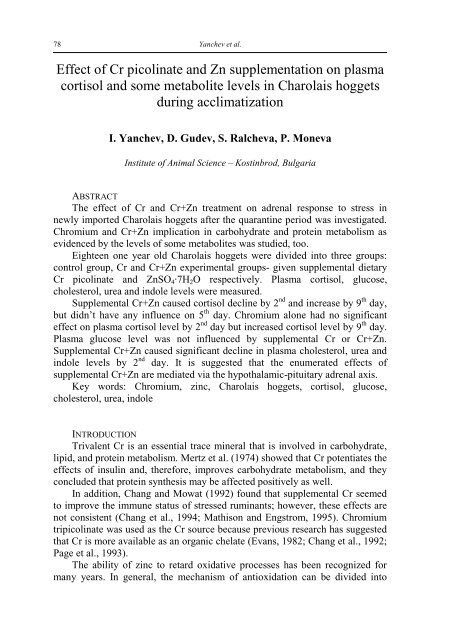
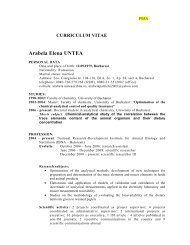
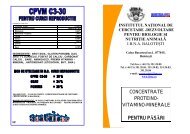
![( ) ( ) [ ] ( ) ( ) ( ) ( ) [ ]n ( ) ( ) [ ]n](https://img.yumpu.com/22443310/1/184x260/-n-n.jpg?quality=85)
